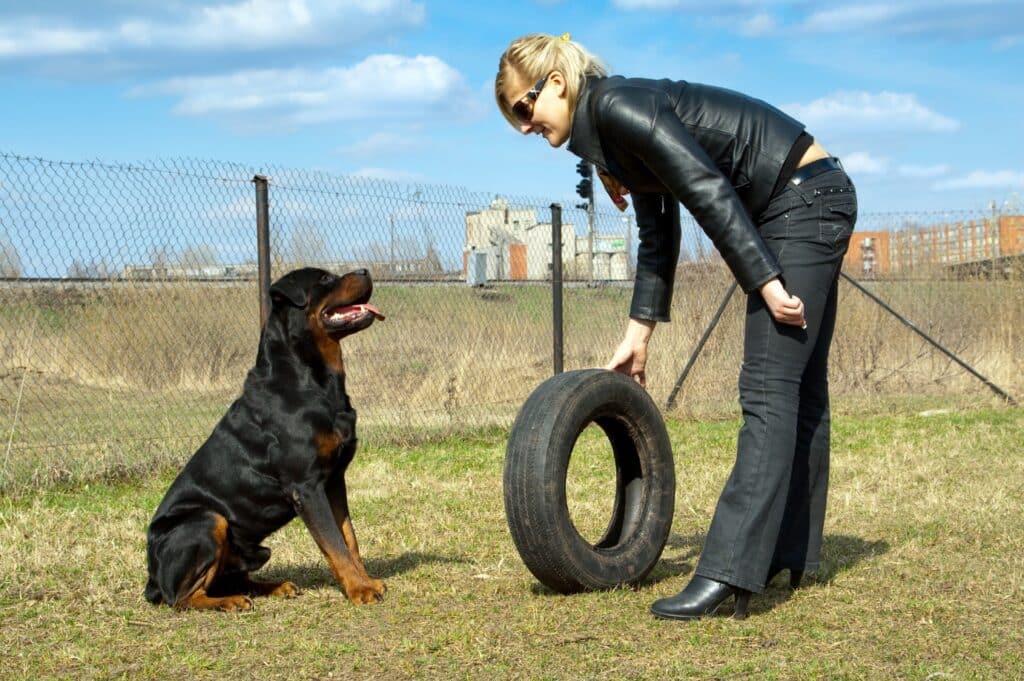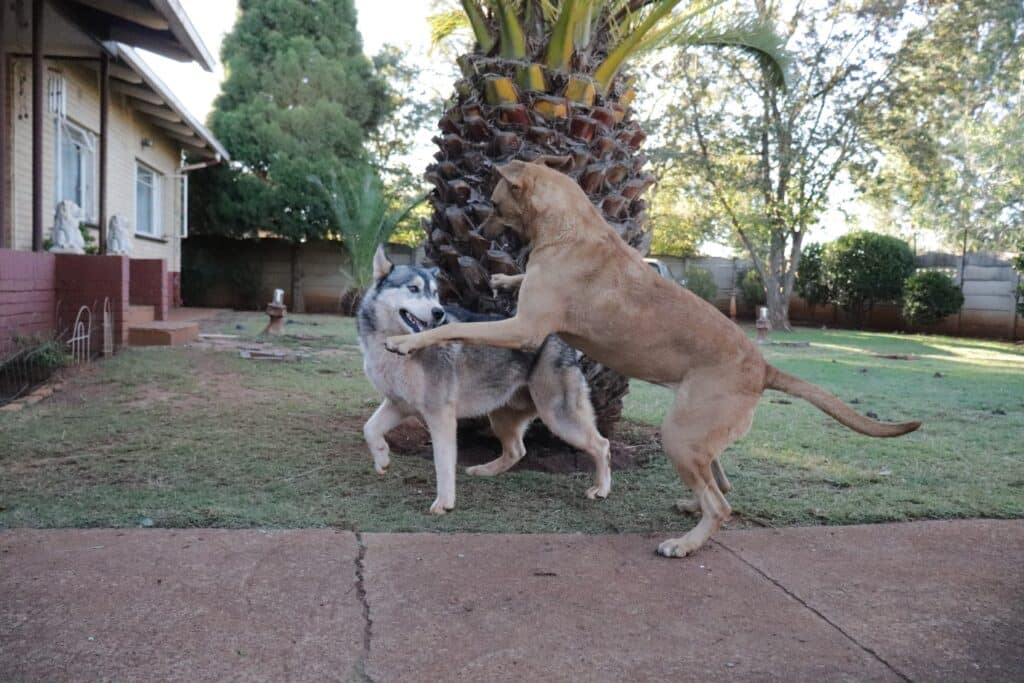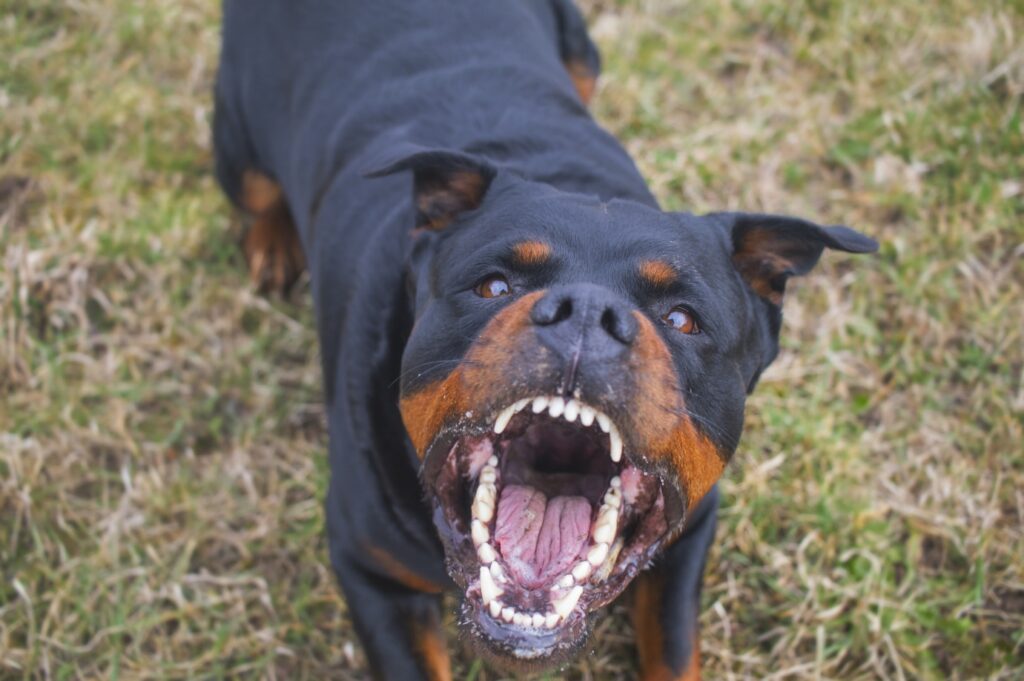Do you love the loyalty of a Rottweiler and the intelligence of a Rhodesian Ridgeback?
Mixing these two breeds together produces an amazing companion that is strong, loyal, and smart. If you’re considering adopting one of these delightful creatures, here are 16 fun facts you should know about them.
From their origins to their modern-day traits and behaviors, this article will give you all the information you need to make the best decision for your family.
Rottweiler Rhodesian Ridgeback Mix – Background
The Rottweiler Rhodesian Ridgeback mix is a hybrid dog developed by crossing a Rottweiler with a Rhodesian Ridgeback. The resulting offspring will typically inherit the best qualities of both parents, making them loyal, intelligent, and protective companions.
Also known as the Rhodesian Rottie, this crossbreed first gained popularity in the United States in the 1990s. While this breed has some incredible traits, they may not be suited to first-time owners due to their imposing size and high energy levels.
Rottweiler Rhodesian Ridgeback Mix – Appearance
Most Rhodesian Rotties will be large dogs with short hair and a ridge of fur along their back.
Some may have the broad head and powerful jaws of a Rottweiler, while others may resemble a Rhodesian Ridgeback more closely.
They are typically 23 to 28 inches in height and weigh around 80 to 100 pounds.
Their short coat could be in various colors, including wheaten, red, black, or brown.
Rottweiler Rhodesian Ridgeback Mix – Temperament
While the Rhodesian Rottie could inherit the temperament of either parent breed, there are certain traits it will likely develop.
“These include intelligence, protectiveness, loyalty, devotion, and high energy levels”.
Coupled with their protective instincts, this breed is likely to have a high prey drive, much like its Rottie parent. This needs to be managed to ensure this breed doesn’t become unruly and aggressive.
Early socialization and obedience training are key requirements and should start once this puppy is 8 weeks of age.
Rottweiler Rhodesian Ridgeback Mix – Training Needs
As this breed is intelligent, they are typically easy to train.
Early obedience classes are highly recommended, however, as their powerful nature, and boundless energy can be a problem for an inexperienced owner.
All training activities should include some type of positive reinforcement, including treats, praise, or affection.
“This breed doesn’t respond well to negative reinforcement and is likely to become confused and anxious and continue its disruptive behavior.“
Failing to provide the appropriate training and early socialization can be an issue for the Rhodesian Rottie, which may result in disruptive and sometimes aggressive behavior.
Rottweiler Rhodesian Ridgeback Mix – Aggression
When considering the aggression levels of this mix, it’s important to look at the temperament of the parent breeds first.
The Rottie can become aggressive if it hasn’t received proper training and is poorly socialized.
This is largely due to their high prey drive and tendencies to be dominant, in which owners need to nurture this dog’s temperament in order to reduce any aggression.
On the other hand, Rhodesian Ridgebacks are quite similar to Rotties, in that they also like to be dominant due to their predatory instincts.
“They are known to show aggression with other dogs and people when they haven’t been socialized or received any formal obedience training”.
It is therefore highly likely that the Rhodesian Rottie will inherit the common traits from its parents, in which it is prone to aggressive tendencies.
Rottweiler Rhodesian Ridgeback Mix – Exercise Needs

The Rhodesian Rottie has high energy levels and requires plenty of daily exercise to stay happy and healthy.
This is certainly no surprise, considering both parent breeds are highly active in nature.
This mix will typically need around 90 minutes of daily exercise, including walking, running, playing fetch, or any other physical activity.
It’s recommended to include some type of vigorous activity every other day to ensure this breed’s excess energy levels are catered for.
Rottweiler Rhodesian Ridgeback Mix – Mental Stimulation

Along with physical exercise, this breed requires lots of mental stimulation to keep their minds sharp.
As an intelligent mixed breed, they thrive on brain games and puzzles, and love nothing more than having their skills tested by their owners!
There are plenty of activities to help stimulate this lovable beast, and can include any of the following:
- Treasure Hunts
- Hide and Seek
- Rotate the Toys
- Obstacle Courses
- Treat dispensing toys
Rottweiler Rhodesian Ridgeback Mix – Grooming Needs
This mixed breed is considered low maintenance when it comes to grooming. As moderate shedders, their coat needs brushing once to twice each week.
This will naturally increase during the shedding season, during the spring and fall.
Bathing is only required every two months or so; doing so more often is likely to strip the oils from their coat and is not recommended.
“Naturally, if your dog is highly active outdoors and frequently dirty, then their bathing requirements will likely increase”.
Their nails should be checked monthly and trimmed as required. The same for their ears, these should be checked to ensure they are clean and free from ear infections.
Rottweiler Rhodesian Ridgeback Mix – Health Conditions
The most common health issues for the Rhodesian Rottie are the following:
Hip Dysplasia: Common among many large dog breeds, especially the Rottweiler parent. This condition is a degenerative joint disease in which the hip joint doesn’t form correctly. While this can be treated, it can be quite painful for this breed and affect their quality of life.
Elbow Dysplasia: Similar to hip dysplasia, this condition involves abnormal growth of the dog’s elbow joint. Whilst treatable, it can lead to discomfort and loss of function.
Bloat: This is a life-threatening condition that can affect the Rhodesian Rottie. This occurs when a dog’s stomach stretches and twists, due to gas being trapped in the area.
This can be an incredibly painful experience for dogs and requires immediate medical attention from a Vet to ensure recovery is possible.
Hypothyroidism: This condition involves the thyroid gland not making enough of the right hormones to convert food into fuel.
Rottweiler Rhodesian Ridgeback Mix – Nutrition
As this breed has high energy levels and a growing appetite, it is best to feed them 2 meals per day, consisting of 3 to 5 cups of quality dog food.
“They need a healthy combination of protein, carbs, and fat for optimal health, along with their fair share of vitamins and minerals.“
Based on their potential health conditions, there are two supplements that I would recommend that have helped our dog in recent times.
Firstly, glucosamine is definitely worth mentioning, as this is great for joint health and can help with the risk of hip or elbow dysplasia.
Fish oil is another great supplement for this breed, as it helps improve the quality of shine of their coats, along with reducing inflammation.
Rottweiler Rhodesian Ridgeback Mix – Dog Friendly?

This breed is typically friendly with other dogs as long as it has been socialized from a young age.
The main things to be aware of are their protective nature and high prey drive. These can be an issue at times, especially with smaller dogs or dogs of the same sex.
“Left unchecked, these traits can lead to unruly behavior and sometimes aggression toward others.“
While these attributes form part of this breed’s genetics, owners can reduce the risk of aggression and disruptive behavior by introducing this mixed breed to other dogs from an early age.
Rottweiler Rhodesian Ridgeback Mix – Child Friendly?
Rhodesian Rotties are very loving to their family and have the energy levels to play for long periods of time. This sounds like fun; however, they may be a danger to small children based on their sheer size and massive energy levels.
They can get along with most children, however, owners of this breed should ensure they are properly socialized at a young age. Teaching your kids how to safely pat this breed will also be important to ensure accidents are avoided.
Do they Drool?
This breed is known as a moderate to heavy drooler, largely due to its parent breeds. Drooling can occur at any time, but is more likely during snack or meal times. It can also happen just after they have exercised heavily.
There are a few things owners can do to minimize the drooling of this breed, including providing smaller meals during the day and access to lots of fresh water at all times.
Barking Levels

The barking levels of this mixed breed will depend on which of the parent breeds they inherit this trait from. The Rottie is likely to bark more often, whereas the Rhodesian Ridgeback is fairly quiet most of the time.
A Rhodesian Rottie will either find its voice early and bark throughout the day or rarely bark at all. It will simply come down to which parent they take after the most!
Early training and positive reinforcement can help if this breed develops a barking problem. As they respond well to treats and praise, it shouldn’t be too difficult to keep their noise levels to a reasonable level!
Adaptability to Weather
Rhodesian Rotties are known for their adaptability to different weather conditions. While they are comfortable in warm and cold weather, they typically prefer moderate temperatures.
Anything below 20 degrees Fahrenheit is dangerous for this breed and increases their risk of hypothermia or frostbite.
They can handle warm climates as high as 80 degrees Fahrenheit. However, they should be kept in a cool area indoors if it gets warmer than this.
Life Expectancy
The Rhodesian Rottie has an average lifespan of 9 to 12 years.
This can be extended or reduced, depending on various factors such as lifestyle, diet, exercise, and genetics.
Puppy Prices
Puppy prices can vary depending on a number of factors. These include the breeder’s location, the pup’s parents’ pedigrees, and whether or not the pup has been spayed or neutered.
However, prices for this breed range from $500-$1000.
Prices are generally cheaper if you find this mixed breed at an animal shelter or rescue organization.


